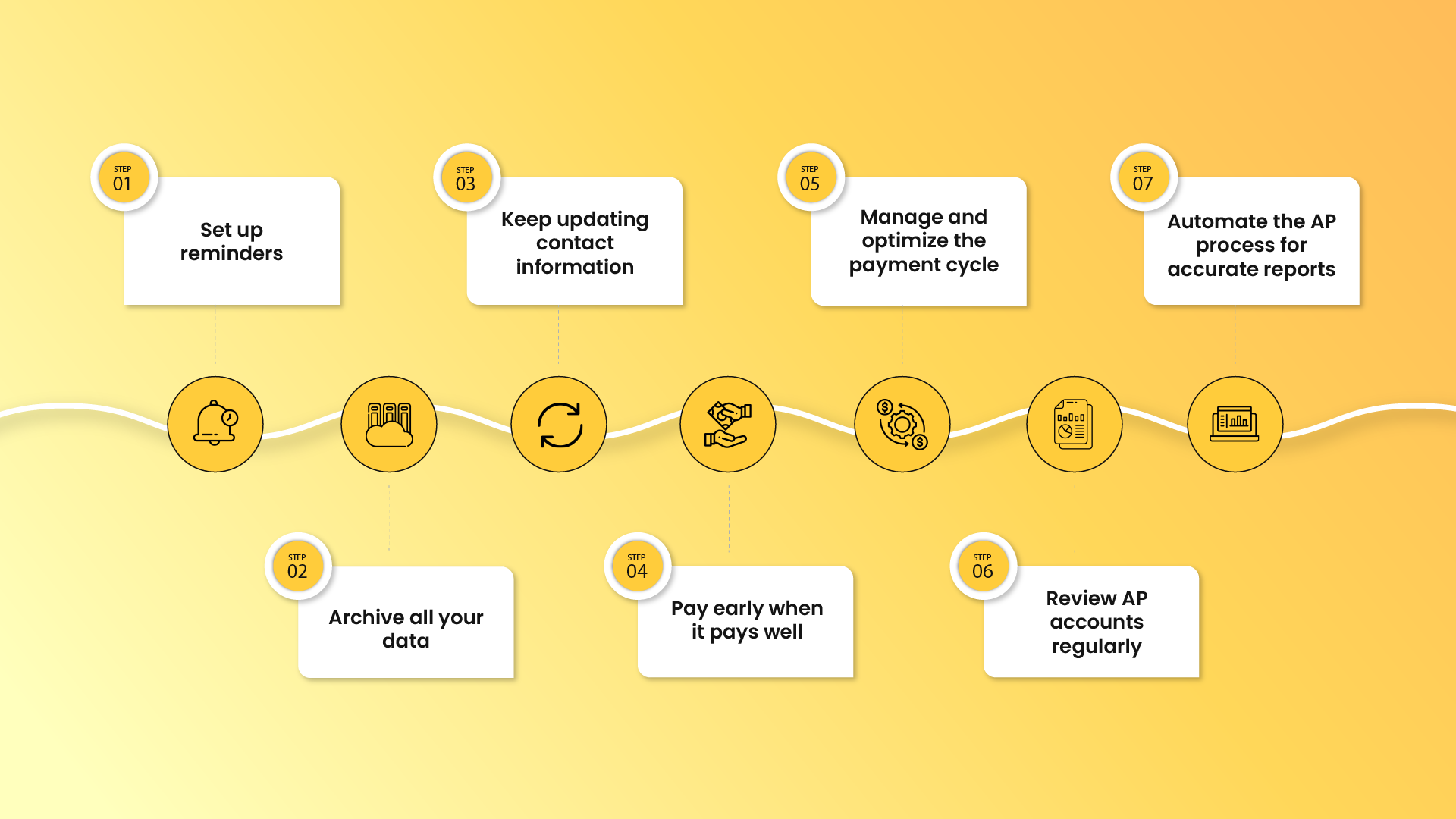When it comes to managing finances, every business knows the importance of a well-functioning Accounts Payable (AP) department. From handling supplier invoices to processing payments, AP is the backbone of financial stability.
But in the dynamic world of business, efficiency is key, and that’s where AP reporting steps in.
This article is a clear and practical guide to help you optimize your AP reporting process and achieve seamless financial operations.
In the following sections, we will explore the most commonly used AP reports that offer valuable insights into your company’s cash flow, liabilities, and payment trends. Moreover, we’ll reveal best practices that can take your AP reporting to the next level, empowering you to make informed decisions, streamline processes, and enhance collaboration with suppliers.
Right then, let’s get in!
What is Accounts Payable Reporting?
In a nutshell, AP reporting is the systematic process of generating, analyzing, and presenting financial data related to a company’s Accounts Payable activities.
It involves compiling information on vendor invoices, payments, outstanding liabilities, and other relevant transactions, and transforming it into insightful reports that aid decision-making and strategic planning.
By utilizing various reporting tools and techniques, businesses gain a comprehensive view of their payables, allowing them to understand cash flow patterns, identify potential bottlenecks, and uncover areas for improvement.
The importance of AP reporting cannot be overstated. It serves as the compass that guides companies toward efficient financial management.
By having a clear picture of outstanding payments and liabilities, businesses can negotiate better terms with suppliers, avoid late fees and penalties, and maintain positive relationships with key partners.
Furthermore, AP reports offer valuable insights for budgeting and forecasting. They enable organizations to accurately predict cash needs, allocate resources wisely, and make strategic financial decisions with confidence.
Most commonly used AP Reports
As we delve deeper into AP reporting, we encounter a diverse array of reports that bring financial clarity and organization to the forefront. Each report serves a specific purpose, unraveling insights and streamlining the Accounts Payable process.
Let’s explore the most commonly used reports one by one, understanding their significance and the benefits they offer.
1. Accounts Payable Aging Report
The Accounts Payable Aging Report is a critical tool for businesses to track their outstanding payables and manage cash flow effectively.
This report categorizes unpaid invoices based on their due dates, organizing them into time buckets such as 30 days, 60 days, 90 days, and beyond.
By providing a clear picture of how much money is owed to vendors and for how long, this report enables AP departments to prioritize payments and avoid late payment penalties. It also helps in identifying potential issues with payment delays and allows businesses to maintain positive relationships with suppliers.
In addition, the Accounts Payable Aging Report aids in forecasting cash flow requirements, ensuring sufficient funds are available to meet upcoming payment obligations.
2. Account Reconciliation Report
The Account Reconciliation Report plays a crucial role in ensuring the accuracy and integrity of financial records. It compares the balances between a company’s internal records and those of its vendors, bank statements, or other external sources.
Discrepancies, if any, can be identified and resolved promptly, preventing potential errors in financial statements.
This report is an essential tool for auditors and financial controllers to verify that all transactions have been appropriately recorded and accounted for, leading to reliable financial reporting.
3. Payment History Report
The Payment History Report provides a comprehensive record of all payments made to vendors over a specified period. It assists AP teams in maintaining transparency in payment activities and facilitates quick reference when queries arise regarding past transactions.
This report is particularly valuable during vendor audits or reconciliations, as it provides a clear timeline of payment activities for each vendor, streamlining the process of resolving discrepancies and clarifying payment histories.
4. Voucher Activity Report
The Voucher Activity Report offers a detailed breakdown of voucher-related activities, including their creation, modification, and approval dates. This report aids in tracking the processing timeline of vouchers, providing insights into potential bottlenecks or inefficiencies in the AP workflow.
Businesses can use this information to optimize their AP processes, improve turnaround times, and enhance accountability within the AP department.
Moreover, the Voucher Activity Report serves as a valuable audit trail, helping auditors and internal controls teams monitor the handling of financial transactions.
5. AP Trial Balance Report
The AP Trial Balance Report consolidates all AP transactions within a specific reporting period, offering a comprehensive snapshot of account balances and outstanding payables.
By summing up all AP-related debit and credit entries, this report serves as an essential tool for verifying the accuracy of recorded transactions.
It helps businesses ensure that the sum of all outstanding vendor balances matches the total amount reported in the AP ledger, thereby maintaining the integrity of financial records and supporting the preparation of accurate financial statements.
6. Vendor Analysis Report
The Vendor Analysis Report focuses on vendor-specific data, providing valuable insights into payment patterns, transaction volumes, and outstanding balances for each vendor.
This report enables businesses to identify key vendors with whom they engage the most and assess their payment behavior.
 Armed with this information, companies can negotiate better payment terms, optimize cash flow, and build stronger relationships with their most crucial suppliers.
The Vendor Analysis Report also supports vendor performance evaluations, enabling businesses to make data-driven decisions regarding vendor selection and management.
7. Credit Memo Report
The Credit Memo Report tracks adjustments made to vendor invoices due to various reasons, such as returned goods, overpayments, or other credit-related matters. It ensures that vendors are appropriately credited for any outstanding amounts, promoting accurate record-keeping and financial transparency.
This report is particularly valuable in cases where disputes arise over invoicing or payment discrepancies, as it provides a clear history of credit adjustments and facilitates smooth communication between the company and its vendors.
8. Discount Report
The Discount Report focuses on discounts availed by the company for early payments to vendors. It highlights the financial benefits of taking advantage of prompt payment opportunities.
By monitoring discount utilization, businesses can optimize their cash flow, reducing the overall cost of goods and services acquired.
This report empowers AP departments to strategically manage payment schedules to maximize cost savings while maintaining healthy vendor relationships.
9. Recurring Invoice Report
The Recurring Invoice Report is indispensable for businesses with recurring expenses or subscriptions. This report simplifies the tracking of regular payable transactions, ensuring that recurring payments are processed accurately and promptly.
By automating the payment of recurring invoices, companies can reduce manual intervention, minimize the risk of missing payments, and streamline their AP processes.
The Recurring Invoice Report also aids in budgeting and forecasting, providing valuable insights into predictable cash outflows over time.
10. AP GL Code Report
The AP GL Code Report serves as a bridge between the AP transactions and the General Ledger (GL) accounts. It maps AP transactions to specific GL codes, ensuring that financial data is appropriately classified and organized for financial reporting purposes.
This report supports accurate allocation of expenses to the relevant GL accounts, simplifying the process of preparing financial statements and ensuring compliance with accounting standards.
How to Improve the AP Reporting Process
Efficient AP reporting not only provides valuable financial insights but also empowers businesses to make informed decisions, optimize cash flow, and maintain strong vendor relationships.
Let’s explore actionable strategies to elevate your AP reporting game and take your financial management to new heights.
- Set up reminders
- Archive all your data
- Keep updating contact information
- Pay early when it pays well
- Manage and optimize the payment cycle
- Review AP accounts regularly
- Automate the AP process for accurate reports

1. Set Up Reminders
Missing payment deadlines can lead to unnecessary penalties and strained relationships with vendors. To avoid this, set up reminders for payment due dates, invoice approvals, and other crucial milestones.
Embrace digital tools such as calendar alerts or task management apps to keep the AP team on track, ensuring timely processing of payments and invoices.
2. Archive all Your Data
A well-organized and comprehensive data archive is an invaluable asset in the world of finance. Create a secure repository for storing all AP-related documents, including invoices, payment records, and vendor communications.
A centralized archive enables quick access to historical transactions, making audits and payment dispute resolutions a breeze.
3. Keep Updating Contact Information
Accurate vendor contact information is the backbone of effective communication. Regularly update and validate vendor contact details, including email addresses, phone numbers, and mailing addresses.
This practice ensures smooth interactions with vendors, reducing the chances of delayed payments due to incorrect information.
4. Pay Early When it Pays Well
Early payments can be financially advantageous if vendors offer discounts as incentives. Take the time to analyze discount terms and assess your cash flow position.
When it aligns with your financial goals, embrace early payments to capitalize on cost savings while nurturing positive vendor relationships.
5. Manage and Optimize the Payment Cycle
Crafting an optimized payment cycle requires strategic planning and negotiation with vendors. Evaluate payment terms, assess supplier reliability, and balance your cash position to determine the best payment schedule.
A well-managed payment cycle enhances working capital management and strengthens partnerships with vendors.
6. Review AP Accounts Regularly
Regularly reviewing AP accounts is a proactive approach to catching and rectifying discrepancies or outstanding payments promptly.
Reconcile vendor statements with internal records to ensure accurate account balances. This practice mitigates the risk of late payments and fosters transparency between your business and its suppliers.
7. Automate the AP Process for Accurate Reports
The transformative power of automation cannot be overstated. Implementing automated AP software like Zapro streamlines invoice processing, payment approvals, and data entry, reducing manual errors and saving valuable time.
Real-time data availability empowers businesses to make well-informed decisions based on accurate and up-to-date information.
To wrap up,
In the world of modern finance, where data reigns supreme, mastering the art of Accounts Payable (AP) reporting is a transformative journey.
As you embark on implementing these best practices, remember that AP reporting is not just about numbers and spreadsheets; it’s about building strong relationships with suppliers, making informed financial decisions, and ensuring the company’s financial stability.
As you continue your financial journey, remember that a well-organized and data-driven AP report process is not just a pathway to success; it’s the very foundation upon which your business thrives and prospers.
In the quest for a seamless AP reporting process, look no further than Zapro.ai. As a comprehensive AP automation software, Zapro emerges as the ultimate ally, simplifying and streamlining every aspect of your Accounts Payable operations, including reporting.
With Zapro, manual data entry becomes a thing of the past, replaced by intelligent automation that captures, processes, and organizes invoices effortlessly. The software’s advanced data extraction capabilities ensure accurate and error-free data, minimizing the risk of discrepancies in your AP reports.
Moreover, Zapro’s intuitive dashboard provides real-time insights into your payables, displaying key metrics, aging summaries, and vendor analysis reports in a visually appealing and user-friendly manner. This centralized view empowers your team to make data-driven decisions promptly, optimizing cash flow and strengthening vendor relationships.
